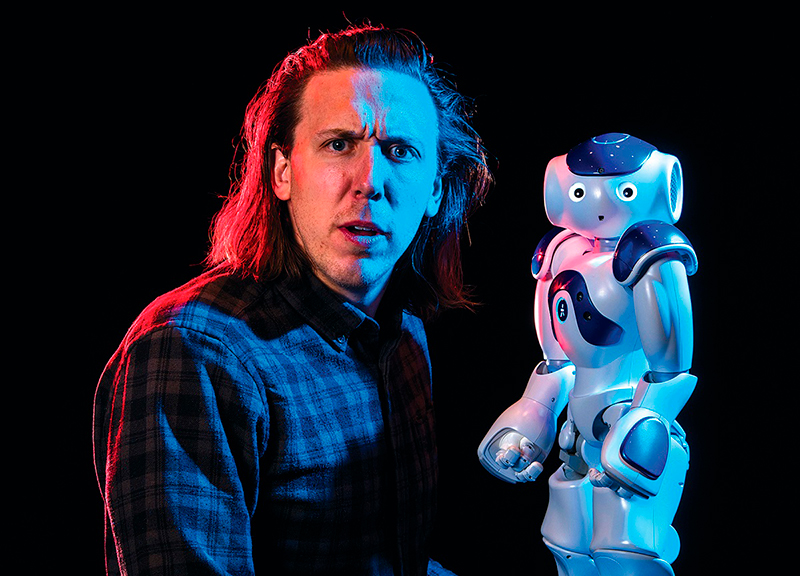When Kory Mathewson, '10 BSc(ElecEng), '14 MSc, takes the stage with Blueberry, the improv comic robot, he starts by telling the audience, "It looks really fancy, so take a deep breath and lower your expectations."
So why combine AI and improv? Because Kory Mathewson, improv comic, is also Kory Mathewson, AI researcher. Neither improv nor AI research really works without embracing repeated failures. The risk that a scene might go off the rails makes watching improv such a fun ride. Likewise, the secret sauce behind training a robot to do improv is that it tries, it fails, it learns, it tries again. And, as Mathewson recounts, there have been a lot of failures to work with.
How was your first show with Blueberry?
It was awful! It was mostly watching someone debug a computer on stage. It said something pretty racy - I had thought I'd filtered for that but I didn't. The audience was like "Whoa! We didn't know it could say that."
Wait - you mean Blueberry has a foul mouth?
[Blueberry's software] uses a database of hundreds of thousands of movie scripts from the last hundred years of cinema. There's a lot of really, really blue content in old movie scripts, so we try to do a lot of filtering in terms of the words we're actually consuming.
Beyond performing, does improv actually help your research?
Robots are really good at doing precise, constrained actions. And that's exactly what improv isn't. Improv is an art form that is judged with a long leash. The audience wants to watch the performers flounder and then succeed in the end. I think that dialogue - improvised dialogue - is the best way for us to watch humans and machines interact.
So working with Blueberry has given you a different perspective?
Blueberry allows me to tell certain stories about the human condition that I wasn't able to frame before - about what our interaction as humans is with these technologies. I'm building a system that I'd love to walk into a dinner party and talk to one day. And wouldn't that be the greatest tragedy? If I walked into a dinner party and didn't talk to you but talked with the robot that was sitting in the corner? So, it's really made me understand and appreciate the moments where I am connected and disconnected.
How Does It Work?
Blueberry is a machine-learning dialogue system inspired by AI research and fed a diet of a hundred years of movie scripts. Blueberry runs software called A.L.Ex. or Artificial Language Experiment, made in collaboration with Piotr Mirowski with HumanMachine in London, England. Here, in a nutshell, is how Blueberry maps language.
- It reads a database of movie scripts to map what sentences look like.
- It tries to make its own sentence, word by word, that looks like sentences from the database.
- If the new sentence reads as though it could come directly from the database, the system increases the probability of making similar sentences.
- Over several guesses and corrections, the system improves its language map.
- When you ask a question, it groups words that occur together, like "hospital, doctor, needle," into topics.
- It uses these perceived topics to create responses that stay within the same topic, mimicking a sentence from the database.

We at New Trail welcome your comments. Robust debate and criticism are encouraged, provided it is respectful. We reserve the right to reject comments, images or links that attack ethnicity, nationality, religion, gender or sexual orientation; that include offensive language, threats, spam; are fraudulent or defamatory; infringe on copyright or trademarks; and that just generally aren’t very nice. Discussion is monitored and violation of these guidelines will result in comments being disabled.